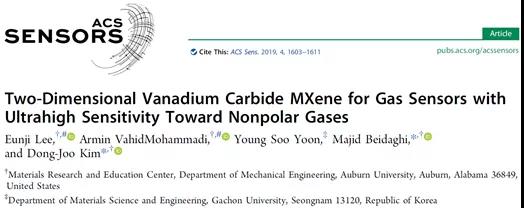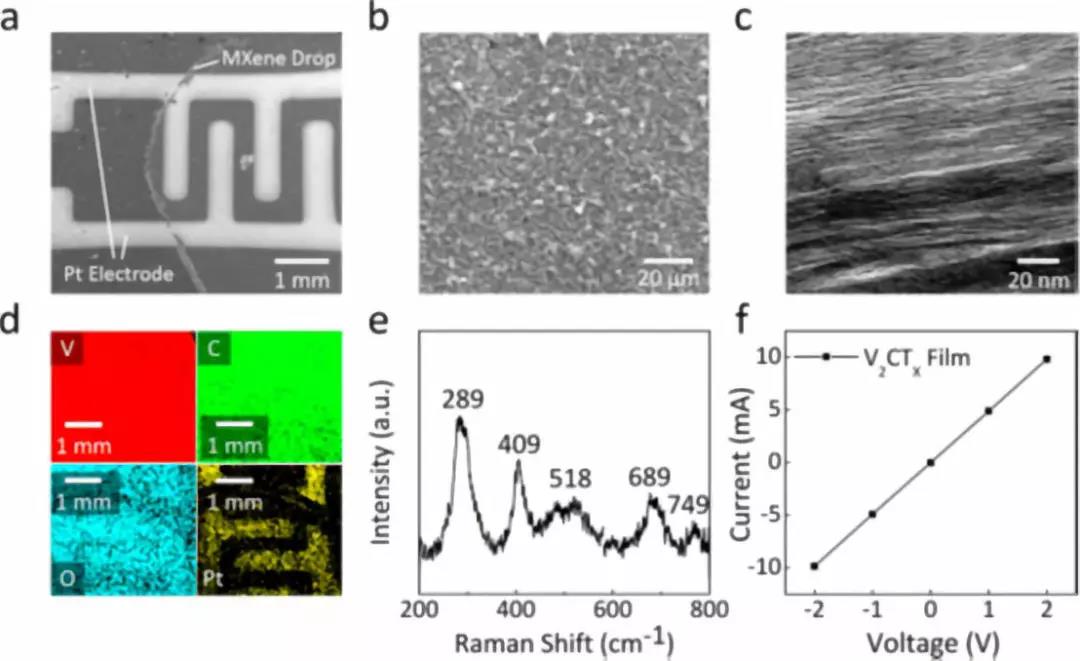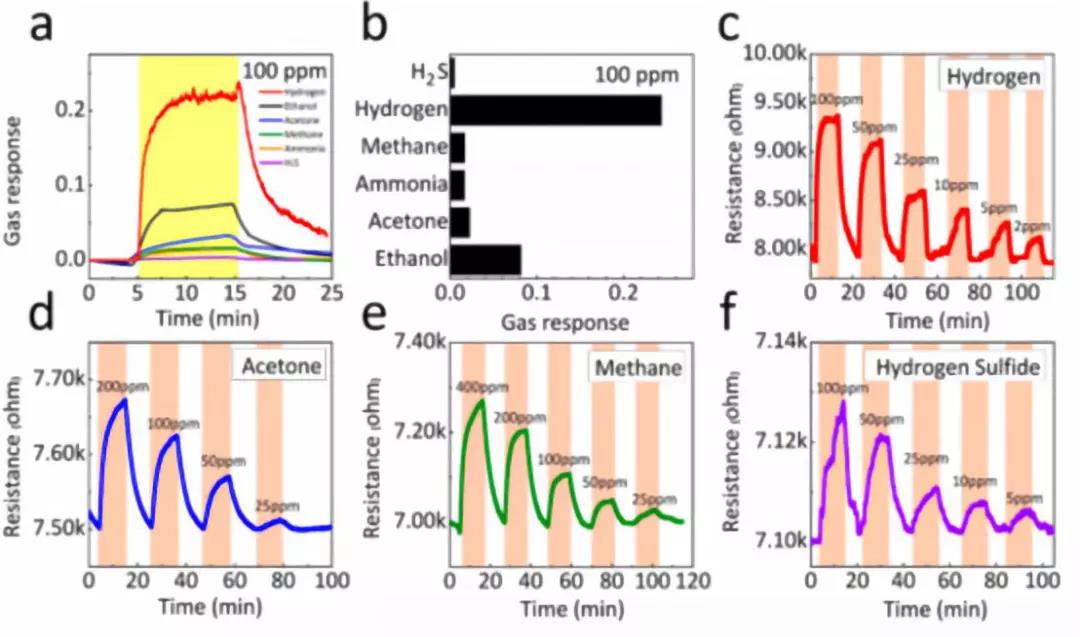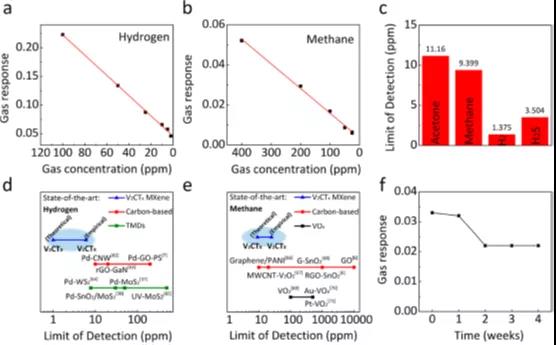
hotline:
17715390137
Tel/Wechat:
18101240246 (Technology)
0512-68565571
Email:mxenes@163.com (Sales Engineer)bkxc.bonnie@gmail.com
Scan the code to follow or search the official account on WeChat:
2D Materials Fronrier After paying attention,
click on the lower right corner to contact us,
Enter enterprise WeChat.
Professional Services Online


【Research Background】
High-performance gas sensing technology is critical in many applications, including environmental monitoring, industrial safety, food safety, and smart home systems, because of the potential environmental, health, and explosion hazards of various gases. For example, in the field of green energy, hydrogen and methane are widely used as fuels, and power generation through fuel cell systems has become more and more commercial. However, the explosion hazard of high pressure hydrogen or methane and its flammability are serious problems in storing and transporting these gases. Therefore, the development of reliable gas monitoring sensors capable of detecting very low (minor) hydrogen and methane leaks is key to overcoming safety challenges and preventing catastrophic events. To achieve this level of sensitivity, the gas sensor should establish a fast and accurate test while maintaining a low operating temperature to avoid high power consumption and to prevent accidental triggering of the explosion. However, the inert nature of these non-polar gases limits their interaction with conventional sensing materials, making them more difficult to detect, especially when they are present in minor amounts.
Two-dimensional materials are one of the most promising materials for future sensing applications due to the unique chemical and physical properties of their adjustable surfaces. Unlike traditional metal oxides, which are widely used in the sensing industry, low temperature gas sensors can be realized using two-dimensional materials such as graphene and transition metal chalcogenides (TMDs). In particular, the high surface-area-to-volume ratio of two-dimensional materials and the ability to tailor them to the desired structure with specific properties have resulted in significant improvements in sensing performance of the device, even for trace gases. Faster, higher order gas response. However, most of the researches on two-dimensional material sensors are focused on the detection of polar molecules, and there are few studies on the application of non-polar and macromolecular detection. This is mainly because most 2D materials have lower sensing performance when detecting non-polar and macromolecules.
Recently, two-dimensional carbonitride MXene has many applications in room temperature gas sensing due to their near-free electron state (NFE), which is different from other two-dimensional materials, which provides an ideal for fast, low-loss carrier transfer. Electronic transmission channel. In particular, the NFE state of V2C(OH) is not occupied, which means it is an easily available electron transfer tool for fast, sensitive detection. In addition, the rich functional groups on the surface of the two-dimensional MXenes expand the interlaminar spacing of the assembled MXenes nanoflakes, increasing the active surface and creating nano-sized interlaminar channels for analyte diffusion between the stacked MXenes.
[Introduction]
Recently, Professor Majid Beidaghi and Professor Dong-Joo Kim of Auburn University reported the room temperature gas response and ultra-high selectivity of layered single/small layer d-V2CTx MXene for non-polar analytes. A gas sensor device was prepared on a flexible polyimide substrate by a simple drop casting d-V2CTx solution method. The unit can detect hydrogen and methane below ppm and other volatile organic compounds (VOCs). The V2CTxMXene gas sensor has a hydrogen detection limit of 2 ppm at room temperature, and its detection performance for non-polar gases exceeds the most advanced 2D gas sensor materials reported so far.
The results were published online at ACS Sensors under the title: Two-Dimensional Vanadium Carbide MXene for Gas Sensors with Ultrahigh Sensitivity Toward Nonpolar Gases.
[Graphic introduction]

Figure 1. (a) Schematic diagram of the synthesis and stratification of V2CTx MXene, showing the structure of V2AlCMAX and the resulting surface functionalized V2CTx MXene. (b) XRD patterns of V2AlC MAX phase and ML-V2CTx, d-V2CTx MXenes. After etching, a new peak appeared in the XRD pattern of ML-V2CTx near 7.95°, corresponding to the (0002) plane of MXene. After TBAOH intercalation, V2CTx is completely layered, causing the (0002) peak to shift to 5.82°, which corresponds to an increase in the d-spacing of MXenes by 4.06 Å, (c) SEM image of ML-V2CTx, (d) vacuum filtration SEM image of d-V2CTx film, AFM image of (e, f) d-V2CTx film and corresponding height profile.

Figure 2. Morphology, structure, and electrical properties of the V2CTx film. (a) SEM image of a V2CTx film deposited on a platinum electrode by drop casting. (b) Top view of the magnified V2CTx film. (c) V2CTx film TEM image of cross section. (d) EDS mapping of V2CTx film. (e) Raman spectroscopy of V2CTx film. (f) IV curve of V2CTx film measured by two-electrode method.

Figure 3. High-resolution XPS spectra of V2CTx. (a) V 2p part, (b) C 1s part, (c) O 1s part, and (d) F 1s part. (e) Sensing mechanism of V2CTx gas sensor schematic diagram.

Figure 4. Gas sensing characteristics of a V2CTx sensor at room temperature (23 ° C). (a) resistance change and (b) gas response to 100 ppm of hydrogen, ethanol, acetone, methane, ammonia, and hydrogen sulfide at room temperature. Real-time sensing response of V2CTx sensors in different concentrations of (c) hydrogen, (d) acetone, (e) methane and (f) hydrogen sulfide.

Figure 5. Gas response at room temperature (23 °C) versus (a) hydrogen (6-200 ppm) and (b) methane (25-400 ppm) analyte concentration. (b) The theoretical limit of detection (LoD) when the signal-to-noise ratio is 3. The latest reference comparison of the room temperature gas sensor to (d) hydrogen and (e) methane LoD indicates that the V2CTx sensor LoD is the lowest. The y-axis in (d) and (e) has no quantitative meaning; the different heights displayed on the y-axis are only used to show different material families. (f) The normal response of the V2CTx sensor to ammonia gas for more than one month at room temperature.
[Summary of this article]
This study produced a 2D V2CTx gas sensor with excellent gas sensing performance and ultra-high sensitivity. A single layer/small layer of V2CTx MXene sheets synthesized by etching and intercalation processes were selected and dropped onto a polyimide sensor substrate. The synthetic 2D V2CTx gas sensor detects trace amounts of various gases, including non-polar gases such as hydrogen and methane. The theoretical LoD of hydrogen is 1 ppm and the methane is 9 ppm, which is the lowest of all reported 2D materials and untreated vanadium-based metal oxides. The paper believes that the excellent gas sensitivity of two-dimensional V2CTx devices is related to the oxygen functional groups on the surface of V2CTx nanosheets. This work can lead to a new gas sensor device based on MXene materials for safe, ultra-sensitive detection of non-polar analytes at room temperature.
Literature link:
Https://doi.org/10.1021/acssensors.9b00303
Source: WeChat public account MXene Frontier

| Reminder: Beijing Beike New Material Technology Co., Ltd. supplies products only for scientific research, not for humans |
| All rights reserved © 2019 beijing beike new material Technology Co., Ltd 京ICP备16054715-2号 |